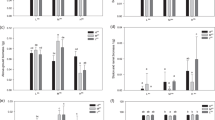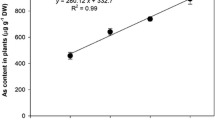Abstract
Hydrilla verticillata (L.f.) Royle is widely distributed and protects the water environment mainly by serving as a potential heavy metal hyperaccumulator. Hydroponic experiments were performed to investigate the biochemical responses of the leaves and stems of H. verticillata at pH values of 5.5, 6.5, 7.5, 8.5, and 9.5 for 7, 14, and 21 days. The results showed that a weak alkaline environment (pH 8.5) promoted plant growth and that an acidic environment (pH 5.5, 6.5) adversely affected normal metabolism. The malondialdehyde content and three antioxidant enzyme activities changed in a similar pattern after the pH treatments: varying increases occurred following all pH treatments with the exception of pH 8.5. The activities of the three N metabolism enzymes briefly increased in an acidic environment and then sharply decreased compared to the control. The ROS-scavenging mechanisms and N metabolism mechanisms in H. verticillata worked together to respond to pH-induced effects. Based on the interplay between antioxidant enzymes and N metabolism enzymes, H. verticillata could defend against the toxicity induced by an acidic environment for approximately seven days and demonstrate stronger adaptability to the alkaline environment. Depending on the growth status and the synergistic effects of the enzymes, an optimum pH of 8.5 for H. verticillata was found in our experiment. Thus, these characteristics reveal a better understanding of this species so that it can be effectively controlled and better referenced for phytoremediation.
Similar content being viewed by others
References
Fernández-Zamudio, R., García-Murillo, P., and Díaz-Paniagua, C., Aquatic plant distribution is driven by physical and chemical variables and hydroperiod in a Mediterranean temporary pond network, Hydrobiologia, 2016, vol. 774, pp. 123–135.
Verhofstad, M.J.J.M., Poelen, M.D.M., van Kempen, M.M.L., Bakker, E.S., and Smolders, A.J.P., Finding the harvesting frequency to maximize nutrient removal in a constructed wetland dominated by submerged aquatic plants, Ecol. Eng., 2017, vol. 106, pp. 423–430.
Parzych, A., Sobisz, Z., and Cymer, M., Preliminary research of heavy metals content in aquatic plants taken from surface water (Northern Poland), Desalin. Water Treat., 2016, vol. 57, pp. 1451–1461.
Rybicki, N.B. and Landwehr, J.M., Long-term changes in abundance and diversity of macrophyte and waterfowl populations in an estuary with exotic macrophytes and improving water quality, Limnol. Oceanogr., 2007, vol. 52, pp. 1195–1207.
Langeland, K.A., Hydrilla verticillata (L.F.) Royle (Hydrocharitaceae), “The Perfect Aquatic Weed,” Castanea, 1996, vol. 61, pp. 293–304.
Sousa, W.T.Z., Hydrilla verticillata (Hydrocharitaceae), a recent invader threatening Brazil’s freshwater environments: a review of the extent of the problem, Hydrobiologia, 2011, vol. 669, pp. 1–20.
Chen, M., Zhang, L.L., Tuo, Y.C., He, X.J., Li, J., and Song, Y., Treatability thresholds for cadmium-contaminated water in the wetland macrophyte Hydrilla verticillata (L.F.) Royle, Ecol. Eng., 2016, vol. 6, pp. 178–186.
Huang, L.Z., Zeng, G.M., Huang, D.L., Li, L.F., Du, C.Y., and Zhang, L., Biosorption of cadmium (II) from aqueous solution onto Hydrilla verticillata, Environ. Earth Sci., 2010, vol. 60, pp. 1683–1691.
Gao, H., Song, Y., Lv, C., Chen, X., Yu, H., Peng, J., and Wang, M., The possible allelopathic effect of Hydrilla verticillata on phytoplankton in nutrient-rich water, Environ. Earth Sci., 2015, vol. 73, pp. 5141–5151.
Wu, J., Cheng, S., Liang, W., and Wu, Z., Effects of organic-rich sediment and below-ground sulfide exposure on submerged macrophyte, Hydrilla verticillata, Bull. Environ. Contam. Toxicol., 2009, vol. 83, pp. 497–501.
Chathuranga, P.D., Dissanayake, D.M.R.E.A., Priyantha, N., Iqbal, S.S., and Iqbal, M.C.M., Biosorption and desorption of lead (II) by Hydrilla verticillata, Bioremediat. J., 2014, vol. 18, pp. 192–203.
Sedmak, J.J. and Grossberg, S.E., A rapid, sensitive, and versatile assay for protein using Coomassie brilliant blue G250, Anal. Biochem., 1977, vol. 79, pp. 544–552.
Heath, R.L. and Packer, L., Photoperoxidation in isolated chloroplasts. I. Kinetics and stoichiometry of fatty acid peroxidation, Arch. Biochem. Biophys., 1968, vol. 125, pp. 189–198.
Beauchamp, C. and Fridovich, I., Superoxide dismutase: improved assays and an assay applicable to acrylamide gels, Anal. Biochem., 1971, vol. 44, pp. 276–287.
Johansson, L.H. and Borg, L.H., A spectrophotometric method for determination of catalase activity in small tissue samples, Anal. Biochem., 1988, vol. 174, pp. 331–336.
Sakharov, I.Y. and Ardila, G.B., Variations of peroxidase activity in cocoa (Theobroma cacao L.) beans during their ripening, fermentation and drying, Food Chem., 1999, vol. 65, pp. 51–54.
Losada, M. and Paneque, A., Nitrite reductase, Methods Enzymol., 1971, vol. 23, pp. 487–491.
Groat, R.G. and Vance, C.P., Root nodule enzymes of ammonia assimilation in alfalfa (Medicago sativa L.): developmental patterns and response to applied nitrogen, Plant Physiol., 1981, vol. 67, pp. 1198–1203.
Duman, F. and Ozturk, F., Nickel accumulation and its effect on biomass, protein content and antioxidative enzymes in roots and leaves of watercress (Nasturtium officinale R. Br.), J. Environ. Sci., 2010, vol. 22, pp. 526–532.
Al-Gabr, H.M., Ye, C., Zhang, Y., Khan, S., Lin, H., and Zheng, T., Effects of carbon, nitrogen and pH on the growth of Aspergillus parasiticus and aflatoxins production in water, J. Environ. Biol., 2013, vol. 34, pp. 353–358.
Singh, K. and Pandey, S.N., Effect of nickel-stresses on uptake, pigments and antioxidative responses of water lettuce, Pistia stratiotes L., J. Environ. Biol., 2011, vol. 32, pp. 391–394.
Srivastava, S., Mishra, S., Tripathi, R.D., Dwivedi, S., and Gupta, D.K., Copper-induced oxidative stress and responses of antioxidants and phytochelatins in Hydrilla verticillata (L.F.) Royle, Aquat. Toxicol., 2006, vol. 80, pp. 405–415.
Singh, A., Kumar, C.S., and Agarwal, A., Effect of lead and cadmium on aquatic plant Hydrilla verticillata, J. Environ. Biol., 2013, vol. 34, pp. 1027–1031.
Anh, B.K., Kim, D.O., Kuschk, P., Tua, T.V., Hue, N.T., and Minhl, N.N., Effect of soil pH on As hyperaccumulation capacity in fern species, Pityrogramma calomelanos, J. Environ. Biol., 2013, vol. 34, pp. 237–242.
Mokhele, B., Zhan, X., Yang, G., and Zhang, X., Nitrogen assimilation in crop plants and its affecting factors, Can. J. Plant Sci., 2012, vol. 92, pp. 399–405.
Gupta, P., Srivastava, S., and Seth, C.S., 24-Epibrassinolide and sodium nitroprusside alleviate the salinity stress in Brassica juncea L. cv. Varuna through cross talk among proline, nitrogen metabolism and abscisic acid, Plant Soil, 2017, vol. 411, pp. 483–498.
Cooper, A.J., The role of glutamine synthetase and glutamate dehydrogenase in cerebral ammonia homeostasis, Neurochem. Res., 2012, vol. 37, pp. 2439–2455.
Dinakar, N., Nagajyothi, P.C., Suresh, S., Damodharam, T., and Suresh, C., Cadmium induced changes on proline, antioxidant enzymes, nitrate and nitrite reductases in Arachis hypogaea L., J. Environ. Biol., 2009, vol. 30, pp. 289–294.
Zhang, L.L., He, X.J., Chen, M., An, R.D., An, X.L., and Li, J., Responses of nitrogen metabolism to copper stress in Luffa cylindrica roots, J. Soil Sci. Plant Nutr., 2014, vol. 14, pp. 616–624.
Author information
Authors and Affiliations
Corresponding author
Additional information
The article is published in the original.
Rights and permissions
About this article
Cite this article
Song, Y., He, X.J., Chen, M. et al. Effects of pH on the Submerged Macrophyte Hydrilla verticillata. Russ J Plant Physiol 65, 611–619 (2018). https://doi.org/10.1134/S1021443718040179
Received:
Published:
Issue Date:
DOI: https://doi.org/10.1134/S1021443718040179




